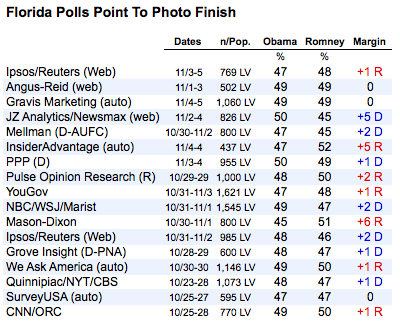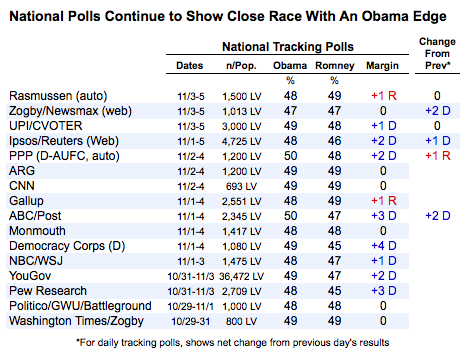My teaching/advising duties are stretching me thin today, so I’m a bit slower with this post than I expected. As I noted in last night’s post, however, the state-based forecast models are all showing an Obama victory in the Electoral College, with very high probabilities. (Keep in mind that the probability of victory is not the same as the predicted margin of victory!) So Drew Linzer is holding steady with Obama winning 332-206, while Sam Wang has Obama up 312-226, although his website promises an update. Simon Jackman’s model is also leaning toward 332 votes for Obama, although that is based on Florida going for the President. That race is still too close call, however, as you can see by this chart.

Meanwhile, as I have suggested would happen, it appears that the national polls have moved slightly in Obama’s favor in the last week, bringing them closer in line with the state-level polling. Here’s a chart from Mark Blumenthal’s Pollster.com site showing the latest national polls:

Pollster.com now has Obama up 48.1-46.7% in the national polls. RealClearPolitics has the national race tighter, with Obama up 48.7-48.1%. So both the national and state-level polls now have Obama ahead.
What might happen to upset these predictions? It would have to be systematic error in the state-level polls. I have said before that the final state poll averages have proved accurate in the past but it is possible that they are underestimating Romney’s support – or overestimating Obama’s. In short, there would have to be a turnout differential that the likely voter screens are systematically missing for Romney to win this race. Certainly the Republicans are more enthusiastic relative to Democrats than was the case four years ago, and Romney’s organization is not facing a resource disparity vis a vis Obama’s either. I could see the case for why that might boost his final support a bit higher relative to Obama’s than the polls are indicating. But how much higher? Let us assume the polls are understating Romney’s support relative to Obama’s by 2%. If we reduce the gap by that much, that would clinch Florida for Romney and bring Colorado and Virginia into virtual ties. But even if we give all three states to Romney – and assume he wins North Carolina – he still falls short with 257 electoral votes. If we inch up his support a hair more, he might squeak by in Iowa – still not enough. At this point I don’t see Obama losing Ohio. So even the most optimistic assessment of the polls from Romney’s perspective still has this race an uphill climb.
A couple of other thoughts. First, I don’t agree that Romney’s decision to run television ads in Pennsylvania was a bluff, or a diversion. I think it made sense. He and Obama have hammered away at each other in Ohio for months, and the state hasn’t budged. In Pennsylvania, however, Obama has much less of a presence, so Romney‘s strategists likely viewed it as a soft target more amenable to stealing. Right now, however, the polls still have Obama up by 5% there, so it is going to take a huge closing surge for Romney to win.
Second point to remember: if the first wave of exit polls is released late afternoon – pay them no heed! They haven’t been adjusted yet to take into account turnout figures.
Everyone and their cousin has advice on how to read tonight’s returns. To me it comes down to Florida for Romney and Ohio for Obama. If the night starts out with Romney losing Florida, the race is over. If Obama loses Ohio, it’s game on.
A reminder – I’ll be live blogging while doing commentary tonight at the Karl Rove Crossroads Cafe. Hope to see you there (if you are local) or online.
More later.


